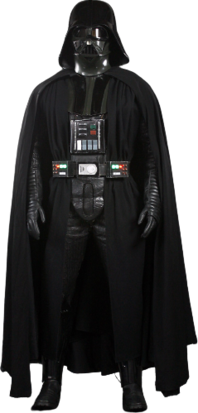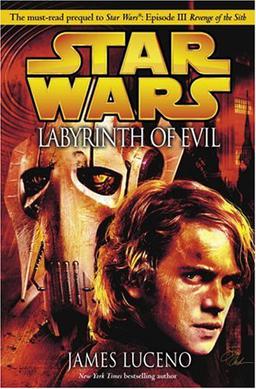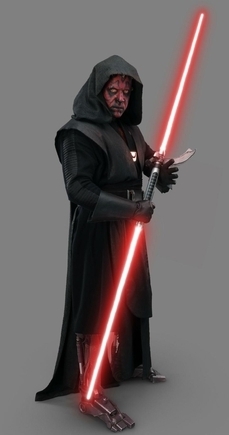
Return of the Jedi is a 1983 American epic space opera film that is a sequel to The Empire Strikes Back (1980). It is the third installment in the original Star Wars trilogy and the sixth chronological film in the "Skywalker Saga". It is directed by Richard Marquand based on a screenplay by Lawrence Kasdan and George Lucas from a story by Lucas, who was also the executive producer. The film follows the ongoing struggle between the malevolent Galactic Empire and the freedom fighters of the Rebel Alliance. As the Rebels attempt to destroy the Empire's second Death Star, Luke Skywalker tries to bring his father, Darth Vader, back from the dark side of the Force. The film stars Mark Hamill, Harrison Ford, Carrie Fisher, Billy Dee Williams, Anthony Daniels, David Prowse, Kenny Baker, Peter Mayhew, and Frank Oz.

Darth Vader is a fictional character in the Star Wars franchise. He was first introduced in the original film trilogy as one of the leaders of the Galactic Empire. The prequel trilogy chronicles his transformation from the Jedi Knight Anakin Skywalker into the Sith Lord Darth Vader. His metamorphosis begins when he is lured to the dark side of the Force by Chancellor Palpatine, who later becomes the Emperor. After a lightsaber battle with his former mentor Obi-Wan Kenobi, Vader is severely injured and is transformed into a cyborg. He serves Palpatine for over two decades, hunting down the remaining Jedi and attempting to crush the Rebel Alliance. When Palpatine tries to kill Vader's son, Luke Skywalker, the Sith Lord turns against his master and destroys him. Vader is the husband of Padmé Amidala, the father of Luke and his twin sister Leia Organa, and the grandfather of Ben Solo.

Star Wars: Episode III – Revenge of the Sith is a 2005 American epic space opera film that is the sequel to The Phantom Menace (1999) and Attack of the Clones (2002). It is the sixth film in the Star Wars film series, the third installment in the Star Wars prequel trilogy, and third chronological chapter of the "Skywalker Saga". It is written and directed by George Lucas, who also served as executive producer. The film stars Ewan McGregor, Natalie Portman, Hayden Christensen, Ian McDiarmid, Samuel L. Jackson, Christopher Lee, Anthony Daniels, Kenny Baker, and Frank Oz.

Yoda is a fictional character in the Star Wars franchise. He is a small, green humanoid alien who is powerful with the Force. He first appeared in the 1980 film The Empire Strikes Back, in which he is voiced and puppeteered by Frank Oz, who reprised the role in Return of the Jedi (1983), the prequel trilogy, the sequel trilogy, and the animated series Star Wars Rebels. Other actors who voice Yoda are Tom Kane, Piotr Michael, John Lithgow, Tony Pope and Peter McConnell. In addition to films and television series, Yoda appears in comics, novels, video games and commercials.

The Galactic Empire, also known simply as the Empire, is a fictional autocracy featured in the Star Wars franchise. Introduced in the 1977 film Star Wars, it is the main antagonistic faction of the original trilogy, which also includes The Empire Strikes Back (1980) and Return of the Jedi (1983). An oppressive dictatorship with a complicated bureaucracy, the Galactic Empire seeks the rule and social control of every planet and civilization within the galaxy, based on anthropocentrism, nationalisation, state terrorism, power projection, and threat of lethal force.

The Clone Wars, also known as the Separatist Crisis, is a fictional conflict in the Star Wars franchise by George Lucas. Though mentioned briefly in the first Star Wars film, the war itself was not depicted until Attack of the Clones (2002) and Revenge of the Sith (2005). The Clone Wars are also the setting for three eponymous projects: a 2D animated series (2003–2005), a 3D film (2008), and a 3D animated series. They have featured in numerous Star Wars books, comics and games.

General Grievous is a character in the Star Wars franchise created by George Lucas. He was introduced in the 2003 animated series Star Wars: Clone Wars, before appearing through computer-generated imagery in the 2005 live-action film Star Wars: Episode III – Revenge of the Sith. Wood reprised the role in the 2008 animated series Star Wars: The Clone Wars and the 2024 anthology series Tales of the Empire.

Star Wars: Labyrinth of Evil is a 2005 novel by James Luceno set in the fictional Star Wars universe. The novel serves as a lead-in to Star Wars: Episode III – Revenge of the Sith, and was loosely adapted into Volume Two of the Star Wars: Clone Wars microseries.

Star Wars: Episode III – Revenge of the Sith is a 2005 action video game based on the movie of the same name. It was released on May 5, 2005, for the PlayStation 2, Xbox, Game Boy Advance, Nintendo DS, and Symbian OS. For the Xbox 360's backwards compatible lineup, Revenge of the Sith is one out of the 400+ backwards compatible games for the 360. As part of the PlayStation 2 classics program, the PlayStation 2 version was re-released in Europe on the PlayStation Network on February 11, 2015, and in North America on April 28, 2015. Meanwhile, the Xbox version was also added to the backwards compatibility list for the Xbox One and Xbox Series X/S on November 15, 2021, A PlayStation Portable version was in development, but was cancelled. It received mixed reviews from critics.
The Star Wars prequel trilogy, colloquially referred to as the prequels, is a series of epic space-opera films written and directed by George Lucas. It was produced by Lucasfilm Ltd. and distributed by 20th Century Fox. The trilogy was released from 1999 to 2005 and is set before the original Star Wars trilogy (1977–1983), chronologically making it the first act of the Skywalker Saga. Lucas had planned a prequel trilogy before the release of the original film, but halted major Star Wars films beyond the original trilogy by 1981. When computer-generated imagery (CGI) had advanced to the level he wanted for the visual effects he wanted for subsequent films, Lucas revived plans for the prequels by the early 1990s. The trilogy marked Lucas's return to directing after a 22-year hiatus following the original Star Wars film in 1977, as well as a 16-year hiatus between the classic and prequel trilogies.

Sith Apprentice is a Star Wars fan film that made its debut on the internet on March 29, 2005, directed by John E. Hudgens and co-written by Hudgens, Denny Humbard, and Men in Black creator Lowell Cunningham. Made for around $1000, it is a spoof of Star Wars and The Apprentice, with Emperor Palpatine filling the Donald Trump role in his search for a new apprentice. The final candidates in the film are Darth Vader, Darth Maul, Count Dooku, and Jar Jar Binks.

Dark Lord: The Rise of Darth Vader is a novel set in the non-canonical Star Wars Legends continuity, written by James Luceno, that was published by Del Rey on November 22, 2005. Dark Lord takes place in the immediate aftermath of the events in Star Wars: Episode III – Revenge of the Sith, and focuses on Darth Vader and his rise to power in the newly inaugurated Galactic Empire.

The Sith are the main antagonists in the fictional universe of the Star Wars franchise. They are the antithesis and ancient enemies of the Jedi. The Sith Order is depicted as an ancient cult of warriors who draw strength from the dark side of the Force and use it to seize power by any means necessary, including terrorism and mass murder; their ultimate goals are to destroy the Jedi and rule the galaxy.

Sheev Palpatine is a fictional character in the Star Wars franchise. He first appeared in the 1980 film The Empire Strikes Back as The Emperor. He is also known by his Sith name, Darth Sidious, which was first used in the novelization of the 1999 film The Phantom Menace.

Darth Maul is a character in the Star Wars franchise created by George Lucas. He first appeared in the prequel film Star Wars: Episode I – The Phantom Menace (1999). Maul returned in the animated television series Star Wars: The Clone Wars and Star Wars Rebels (2014–2018), as well as the standalone film Solo: A Star Wars Story (2018). Lucas had intended for Maul to feature in the sequel film trilogy, but these plans were discarded when Disney acquired Lucasfilm in 2012.

Star Wars Transformers is a Hasbro toy line started in 2006. The line features robot versions of various characters from the Star Wars franchise that transform into vehicles from the same series. Now, they can usually range from $30 to $400, depending on the product.

Darth Plagueis is a fictional character in the Star Wars franchise created by George Lucas. A Sith Lord with the ability to cheat death and create life, Plagueis is the enigmatic mentor of Palpatine, who eventually betrays Plagueis by murdering him in his sleep, taking his place as Sith Master in accordance with the Sith's Rule of Two. The character was first mentioned on-screen in the 2005 film Star Wars: Episode III – Revenge of the Sith, in which Palpatine frames his life and death as a "legend" to pique Anakin Skywalker's curiosity about the dark side of the Force. Plagueis has a more prominent presence in the Star Wars Expanded Universe.

Vader Episode I: Shards of the Past is a 2018 Star Wars fan film created by Star Wars Theory. On December 20, 2018, a screening was held at the Landmark's Regent Theatre in Los Angeles, CA, and on December 21, 2018, it was released to YouTube. As of October 2022, a sequel, Vader Episode II: The Amethyst Blade is in pre-production. About six minutes of the episode have been released on YouTube via two cinematic teasers, and the full episode is expected to release within the next couple years with a planned third episode in early development.

Star Wars: The Secrets of the Sith is a Star Wars novel written by Marc Sumerak with illustrations by Sergio Gómez Silván. Published by Insight Editions, the book offers an immersive exploration of the Sith, narrated from the perspective of Emperor Palpatine. It serves as a companion to Sumerak’s earlier work, The Secrets of the Jedi, expanding the universe's lore by exploring Sith philosophies, characters, and notable historical events.


















